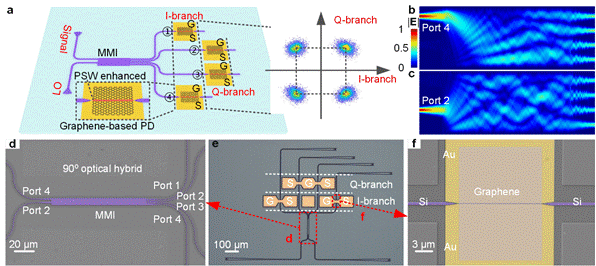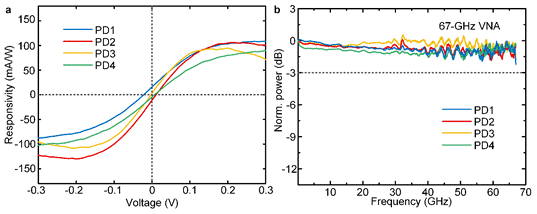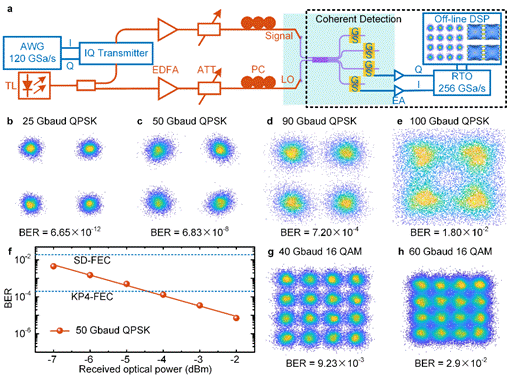Nature Communications published online a research finding – the ultrahigh-speed graphene-based optical coherent receiver (OCR) – on August 20th, which was a cooperation project of Professor Zhang Xinliang and Associate Professor Ye Lei from Wuhan National Laboratory for Optoelectronics and School of Optical and Electronic Information, HUST, and Dr. Xiao Xi from National Optoelectronics Innovation Center, Wuhan. It was the world’s first high-speed graphene-based optical coherent receiving chip applied for digital coherent optical communications, creating new possibilities for the ultrahigh-speed coherent optical communications network in the future.
The fast-evolving mobile Internet and explosive data growth require the capacities of the optical fiber communications networks to be continuously expanded. Coherent optical communications technology, adopting advanced modulation formats and digital signal processing, can increase the spectral efficiency and the data transmission capacity and represents an epoch-making optical communications technology that has promoted the evolution of optical transmission networks in the past decade. Within the coherent optical communications systems, OCR is one of the key devices, as it can simultaneously detectphase and amplitude carried by high-speed signals. In addition, thanks to balanced detection, OCR possesses a higher detection sensitivity compared with direct detection optical receivers.
Graphene has been widely studied in the research of photodetectors for the past 10 years due to its advantages of high carrier mobility, ultra-broadband spectral response, and integration capability with on-chip photonics platforms. Graphene-based photodetectors with high-speed (~500GHz) performance, high responsivity, and compact footprint are significantly applicable in optical communications systems. Currently, the research has demonstrated that with the greatly enhanced light–graphene interaction and high-speed characteristics of plasmonic structures, the graphene-based photodetectors enabled by the plasmonic structures have shown a compact size of about 10 μm, a high responsivity up to 0.7 A/W, a large bandwidth of 110 GHz, and a high receiving capacity of over 100 Gbit/s. However, graphene-based photodetectors based on direct detection is still hard to be applied in high-speed 200Gbit/s, 400Gbit/s, or even 800Gbit/s optical interconnections. Therefore, based on large-bandwidth graphene-based photodetectors and coherent detection, OCR will have a chance to realize a large bandwidth and a high-quality large-capacity data reception. Meanwhile, compared with the OCRs with the conventional photodetectors based on III–V46 and Si–Ge47 platforms, the graphene-based OCR combines the benefits of high-speed operation and CMOS-technology compatibility.
Previously, Professor Zhang Xinliang and his team had researched high-speed graphene-on-plasmonic slot waveguide photodetectors (ECOC2019), and by combining with polarization multiplexing technology, they materialized optical receiving chips with a reception capacity as large as 224Gbit/s (Adv. Opt. Mater. 9, 2001215,2021). On such a basis, the team defined the proposed plasmonic graphene-based OCR (Fig. 1a) and combined the 90-degree optical hybrid and four-channel graphene-on-plasmonic slot waveguide photodetectors, realizing, for the first time, the graphene-based optical coherent receiving chips capable of detecting advanced modulation formats (Fig. 1e). The 90-degree optical hybrid utilizes a 4 × 4 multimode interference (MMI) coupler (Fig. 1b~1d), meaning that no extra phase control units are needed to realize the relations of the four-channel output port phase required by OCR. Thus, this technique is simple and convenient. With graphene-on-plasmonic slot waveguide photodetectors (Fig. 1f), graphene-based OCR chips demonstrated active detection sections of 4* 15 μm* 100 nm, a responsivity of 0.1 A/W (Fig. 2a), and a response bandwidth exceeding 67 GHz (Fig. 2b).

Fig. 1
a: Schematic diagram of the graphene-based OCR; b/c: Optical field propagation of the 90-degree optical hybrid; d: False-color SEM image of the 90-degree optical hybrid; e: Optical microscopy image of the proposed OCR; f: False-color SEM image of a graphene-based photodetector.

Fig. 2
a: The responsivity as a function of the bias voltage for the four photodetectors; b: Frequency responses of the four photodetectors.

Fig. 3
a: Measurement setup for high-speed signal receiving; b-e: Constellation diagrams of QPSK signals; f: Measured bit error ratios (BERs) versus the received optical power for 50 Gbaud QPSK signal; g-h: Constellation diagrams of 40 Gbaud (g) and 60 Gbaud (h) 16 QAM signals.
The measurement setup as shown in Fig. 3a verified the balanced detection and coherent detection of graphene-based optical coherent receiving chips. In specifics, through homodyne coherent detection and offline digital signal processing algorithms, the device successfully performed single-polarization and advanced modulation formats reception at an ultrahigh speed of 200Gbit/s QPSK (100Gbaud) and 240Gbit/s 16QAM (60Gbaud) (Fig. 3e, 3h).
By effectively integrating the advantages of graphene-based optical electronics, plasmonics, and silicon photonics, the ultrahigh-speed graphene-based OCR boasts large bandwidth, low power consumption, and micron-scale sizes, provides fresh insights to develop high-speed, high-efficiency, and miniaturized OCR, and enjoys unique competitiveness in next-generation high-speed optical interconnections, such as data centers.
The research was granted support by the Ministry of Science and Technology and the National Natural Science Foundation. Professor Zhang Xinliang and Professor Ye Lei of HUST and Dr. Xiao Xi from the National Optoelectronics Innovation Center were co-corresponding authors. Doctoral student Wang Yilun in HUST and postdoctoral fellow Li Xiang in the University of Cambridge were both first authors. Moreover, Professor Yu Yu, postdoctoral fellow Zhou Hailong, and doctoral students Jiang Zhibin, Tong Lei, Deng Wentao, Gao Xiaoyan, and Huang Xinyu, all in HUST, also contributed to the research.
Link to the paper: https://www.nature.com/articles/s41467-021-25374-0
Edited by: Lai Xiangyu, Peng Yumeng
